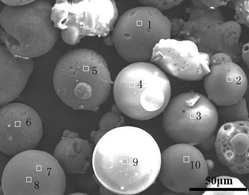Crossref Citations
This article has been cited by the following publications. This list is generated based on data provided by
Crossref.
Liu, Zhiwei
Wang, Xiaoming
Han, Qingyou
and
Li, Jianguo
2014.
Synthesis of submicrometer-sized TiC particles in aluminum melt at low melting temperature.
Journal of Materials Research,
Vol. 29,
Issue. 7,
p.
896.
Lyu, Yezhe
Sun, Yufu
and
Jing, Fengyu
2015.
On the microstructure and wear resistance of Fe-based composite coatings processed by plasma cladding with B4C injection.
Ceramics International,
Vol. 41,
Issue. 9,
p.
10934.
Lyu, Yezhe
Sun, Yufu
and
Yang, Yong
2016.
Non-vacuum sintering process of WC/W2C reinforced Ni-based coating on steel.
Metals and Materials International,
Vol. 22,
Issue. 2,
p.
311.
Mohanavel, V.
Rajan, K.
Kumar, S. Suresh
and
Ganeshan, P.
2017.
Manufacturing and mechanical characterization of dual particle reinforced hybrid composites.
p.
1.
Khan, Mahmood
Amjad, Maham
Khan, Ansa
Ud-Din, Rafi
Ahmad, Iftikhar
and
Subhani, Tayyab
2017.
Microstructural evolution, mechanical profile, and fracture morphology of aluminum matrix composites containing graphene nanoplatelets.
Journal of Materials Research,
Vol. 32,
Issue. 11,
p.
2055.
Mohanavel, V.
Suresh Kumar, S.
Sathish, T.
Adithiyaa, T.
and
Mariyappan, K.
2018.
Microstructure and mechanical properties of hard ceramic particulate reinforced AA7075 alloy composites via liquid metallurgy route.
Materials Today: Proceedings,
Vol. 5,
Issue. 13,
p.
26860.
Reddy, P. Subramanya
Kesavan, R.
and
Vijaya Ramnath, B.
2018.
Investigation of Mechanical Properties of Aluminium 6061-Silicon Carbide, Boron Carbide Metal Matrix Composite.
Silicon,
Vol. 10,
Issue. 2,
p.
495.
Movahedi, Nima
Taherishargh, Mehdi
Belova, Irina V.
Murch, Graeme E.
and
Fiedler, Thomas
2018.
Mechanical and Microstructural Characterization of an AZ91–Activated Carbon Syntactic Foam.
Materials,
Vol. 12,
Issue. 1,
p.
3.
Sreenatha Reddy, S.
and
Dhanasekaran, R.
2018.
Effect of fly ash and basalt on wrought and cast aluminum alloy.
Materials Today: Proceedings,
Vol. 5,
Issue. 13,
p.
27112.
Joy, Nivin
Subrahmanyan, Kommoju Rohit
and
Ram, Oduri Pavan
2020.
Study of mechanical and surface properties of aluminium MMC reinfroced with boron carbide.
Vol. 2311,
Issue. ,
p.
070029.
Poornachandiran, N.
Pugazhenthi, R.
Vijay Ananth, S.
Krishnan, T. Gopala
and
Vairavel, M.
2020.
Investigation of mechanical properties of Al6061 with reinforcement of SiC/B4C metal matrix composites.
Vol. 2283,
Issue. ,
p.
020113.
Gunawan
Arifin, A
Akbar, M A
and
Asura, I
2020.
Effect of fly ash content in Aluminum matrix composite through stir casting method on mechanical and physical properties.
IOP Conference Series: Materials Science and Engineering,
Vol. 857,
Issue. 1,
p.
012008.
Samvatsar, Kaustubh
and
Dave, Harsh
2021.
A comprehensive study on using fly ash as reinforcement material in aluminium and magnesium based syntactic foams.
Materials Today: Proceedings,
Vol. 47,
Issue. ,
p.
2384.
Hameed, Abdul Zubar
and
Alagarasan, Krishnaraju
2021.
An investigation report on sustainable strength of amalgamation materials.
Materials Today: Proceedings,
Vol. 47,
Issue. ,
p.
5157.
Mussatto, Andre
Ahad, Inam UI
Mousavian, Reza Taherzadeh
Delaure, Yan
and
Brabazon, Dermot
2021.
Advanced production routes for metal matrix composites.
Engineering Reports,
Vol. 3,
Issue. 5,
Chakrapani, P.
and
Suryakumari, T.S.A.
2021.
Mechanical properties of aluminium metal matrix composites-A review.
Materials Today: Proceedings,
Vol. 45,
Issue. ,
p.
5960.
Pratap, Chandra
Chandra, Prakash
Butola, Ravi
and
Shukla, Anurag
2022.
Fabrication and Characterization of AA6063/B4C Metal Matrix Surface Nanocomposite Using Friction Stir Processing.
ECS Journal of Solid State Science and Technology,
Vol. 11,
Issue. 3,
p.
033010.
Luo, Kaiguang
Liu, Shilei
Xiong, Hanqing
Zhang, Yun
Kong, Charlie
and
Yu, Hailiang
2022.
Mechanical Properties and Strengthening Mechanism of Aluminum Matrix Composites Reinforced by High-entropy Alloy Particles.
Metals and Materials International,
Vol. 28,
Issue. 11,
p.
2811.
Yan, Shiqin
Chen, Ling
Yob, Andrew
Renshaw, David
Yang, Kun
Givord, Michel
and
Liang, Daniel
2022.
Multifunctional Metal Matrix Composites by Friction Stir Additive Manufacturing.
Journal of Materials Engineering and Performance,
Vol. 31,
Issue. 8,
p.
6183.
Mathapati, Mahantayya
Amate, Kiran
Durga Prasad, C.
Jayavardhana, M.L.
and
Hemanth Raju, T.
2022.
A review on fly ash utilization.
Materials Today: Proceedings,
Vol. 50,
Issue. ,
p.
1535.



